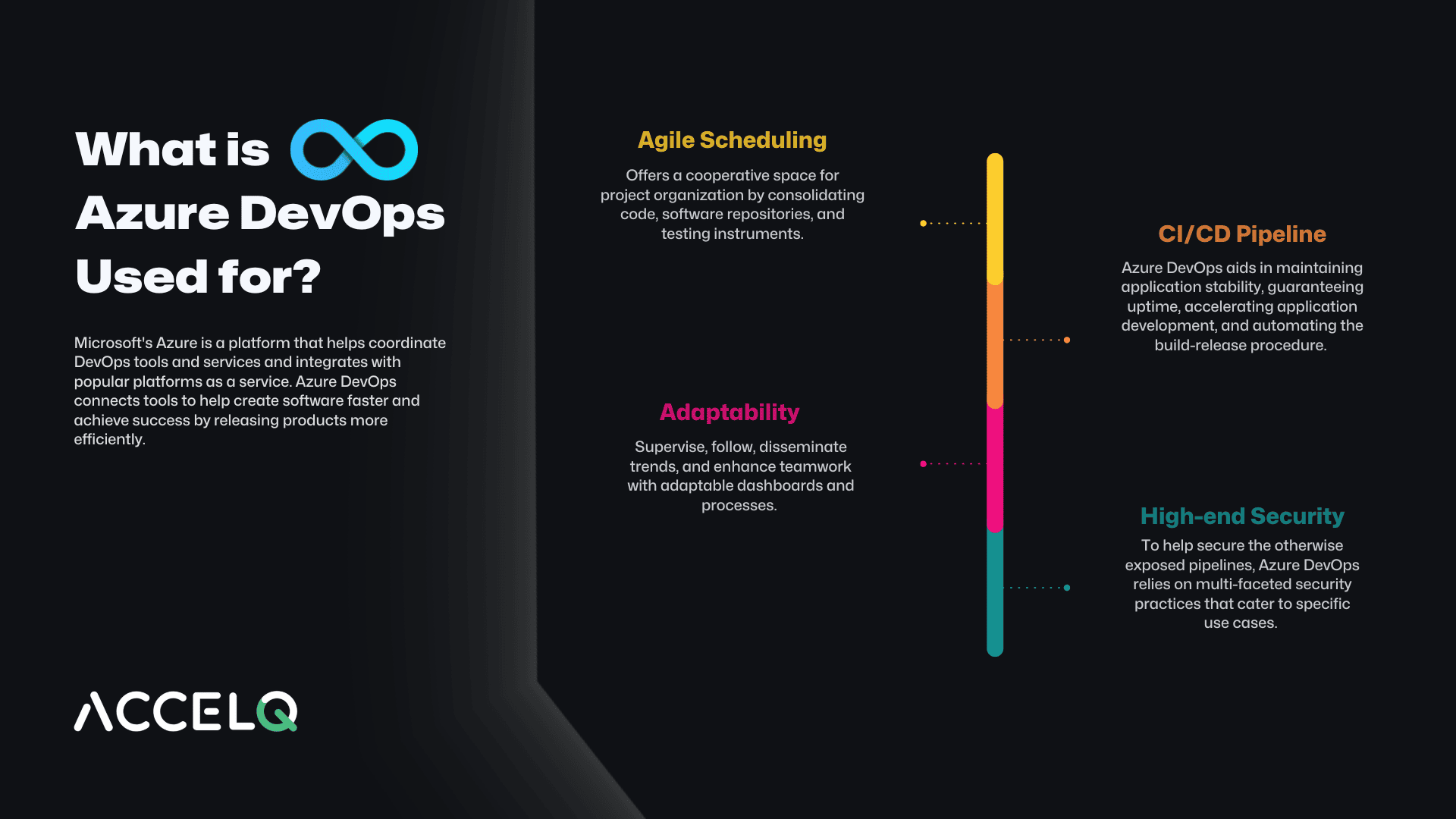What is Azure DevOps and how is it used? Why automate Azure DevOps?

Microsoft's Azure is a platform that helps coordinate DevOps tools and services and integrates with popular platforms as a service. Azure DevOps connects tools to help create software faster and achieve success by releasing products more efficiently. Azure DevOps test Automation uses tools and methods to automate tasks in a DevOps pipeline. It can automate building, deploying applications, testing code, and managing infrastructure.
What is Azure DevOps?
Microsoft's Azure DevOps platform is a collection of services and uses a fully integrated set of DevOps tools. The platform enables software engineers to maintain a log of host source code repositories, implement scheduled workflows, and leverage CI\CD pipelines.
It also adds power to DevOps models across different cloud and on-premises environments (cloud and on-premises), managing software products before they are shipped. Azure DevOps is an extensive platform that can help teams handle the end-to-end software development lifecycle, including test automation. Azure DevOps does not prioritize automated testing. However, it offers features and integrations that teams can use within a DevOps workflow.
A note on Azure DevOps lifecycle:
Azure DevOps contains a range of services that cover the complete software development lifecycle. These are:
- Azure boards: They help teams track, plan, visualize work that needs to be done. It offers four processes such as CMMI, Scrum, Agile, and Basic.
- Azure Pipelines: Azure Pipelines is cloud-based and can automatically build, test, and deploy any code project. It is a cloud-agnostic CI/CD platform with support for containers or Kubernetes and can work with any language or project type.
- Azure Repos: provides unlimited, cloud-hosted, both private and public Git Repos.
- Azure Artifacts: This tool helps create, host, and share packages while providing integrated package management with support for Maven, npm, Python, etc.
- Azure Test Plans: provide both manual and exploratory testing solutions.
SUGGESTED READ - Test Automation in Azure DevOps with ACCELQ
What is Azure DevOps Used for?
Agile Scheduling
Offers a cooperative space for project organization by consolidating code, software repositories, and testing instruments. This aids in tracing the modifications in code and the corresponding test-related elements throughout the team.
CI/CD Pipeline
Azure DevOps aids in maintaining application stability, guaranteeing uptime, accelerating application development, and automating the build-release procedure. Thanks to its robust independent services like Azure Pipelines, Azure DevOps enables the systematic, automated execution of tasks across different environments.
Adaptability
Supervise, follow, disseminate trends, and enhance teamwork with adaptable dashboards and processes. This also includes the feature of adjustable widgets and alerts and the capacity to select relevant services within the corporation.
High-end Security
To help secure the otherwise exposed pipelines, Azure DevOps relies on multi-faceted security practices that cater to specific use cases. These could range from implementing incremental approaches to changing the project structure to even employing security templates.
How to use Azure DevOps?
Azure DevOps provides a suite of services covering the entire development lifecycle, including Azure Boards for project planning and tracking, Azure Repos for source control, Azure Pipelines for continuous integration and delivery, Azure Test Plans for testing, and Azure Artifacts for package management. Here's a step-by-step guide to get started:
1. Create an Azure DevOps Organization
Go to the Azure DevOps website and sign in with your Microsoft account. Now, create a new organization by specifying the name of the organization and the location where your data will be stored.
2. Create a Project
Inside your organization, create a new project by providing a name and a description for your project. Choose the visibility of your project (public or private).
3. Set Up the Team and Permissions now
Azure Artifacts is a service, which aims to bring a more cohesive experience for developers and users by providing tools for uploading, sharing, and tracking all kinds of packages (registries like Maven, NuGet) across the organization. It further helps assimilate such artifacts into the Azure pipeline.
4. Plan and Track Work Using Azure Boards
Use Azure Boards to create work items like user stories, tasks, bugs, and features. Now, organize work into sprints, track progress on dashboards, and use Kanban boards for agile project management.
5. Manage Your Code with Azure Repos
Set up Git repositories in Azure Repos to manage source code and clone the repository to the local machine, make changes, and push commits. You could use pull requests to review and merge code changes.
6. Automate Builds and Deployments Using Azure Pipelines
Create a pipeline in Azure Pipelines to automate the application's build and deployment. Define the build steps, triggers for the pipeline (like commits to a specific branch), and the environments for deployment. Monitor the pipeline runs and view logs to troubleshoot any issues.
7. Test Application with Azure Test Plans
Create test plans, test suites, and test cases to outline a testing strategy. Execute manual or automated tests and track test results to ensure quality.
8. Share Packages with Azure Artifacts
Use Azure Artifacts to host and share packages like NuGet, npm, or Maven within the organization or with the public. Configure development tools to use packages from the Azure Artifacts feed.
9. Monitor and Improve Processes
Use Azure DevOps's analytics and reporting features to monitor project health, progress, and productivity. Based on insights and feedback, adjust your processes and practices.
10. Integrate with Other Services
Azure DevOps can be integrated with various external services and tools to enhance workflows, such as Slack for communication, SonarQube for code quality analysis, or various cloud platforms for deployment.
Why use Azure DevOps test automation?
Azure DevOps is compatible with any programming language or operating system, and hence, it is an excellent option for both well-established development teams and beginners in test automation. Azure DevOps is a platform for developing and deploying cloud-based software applications that also offers a selection of built-in test automation features.
Note the following:
- Developing and delivering applications can be accelerated by using test automation capabilities offered by Azure DevOps.
- This will bring down the amount of manual testing required.
- It is possible to catch bugs and problems early in development.
- Improved quality in codes and enhanced reliability of applications.
Getting started: Azure DevOps automation testing with ACCELQ integration.
Azure DevOps helps teams work together better and deliver apps faster and is essential for the DevOps approach to software development. ACCELQ works closely with Azure DevOps and Dynamics 365 to speed up development by automating tasks and saving time and resources. This is achieved by:
- AI-driven Codeless Automation: From test management to execution tracking, ACCELQ makes everything straightforward with its agile dashboard and visual app models.
- Continuous Testing: ACCELQ leverages in-sprint automation automated cloud-based executions and integrates with Azure DevOps to achieve a complete end-to-end testing experience.
Learn more about how ACCELQ uses Azure DevOps to successfully manage code test coverage and build and release. Contact us!
Geosley Andrades
Director, Product Evangelist at ACCELQ
Geosley is a Test Automation Evangelist and Community builder at ACCELQ. Being passionate about continuous learning, Geosley helps ACCELQ with innovative solutions to transform test automation to be simpler, more reliable, and sustainable for the real world.
Discover More
 QA in Agile Methodology: Best Practices & Implementation for 2025
QA in Agile Methodology: Best Practices & Implementation for 2025
QA in Agile Methodology: Best Practices & Implementation for 2025
 The Top 7 UI Test Automation Best Practices
The Top 7 UI Test Automation Best Practices

































